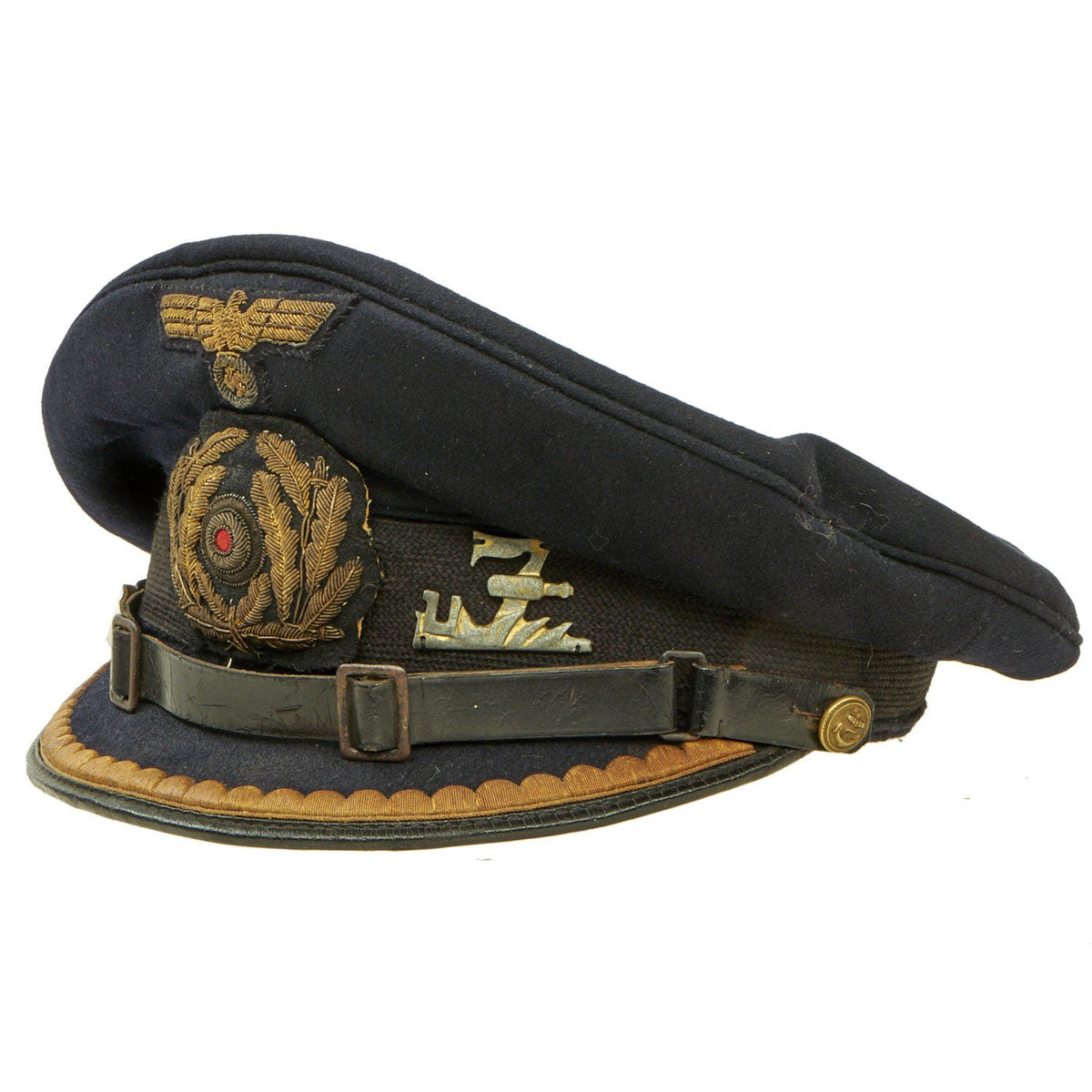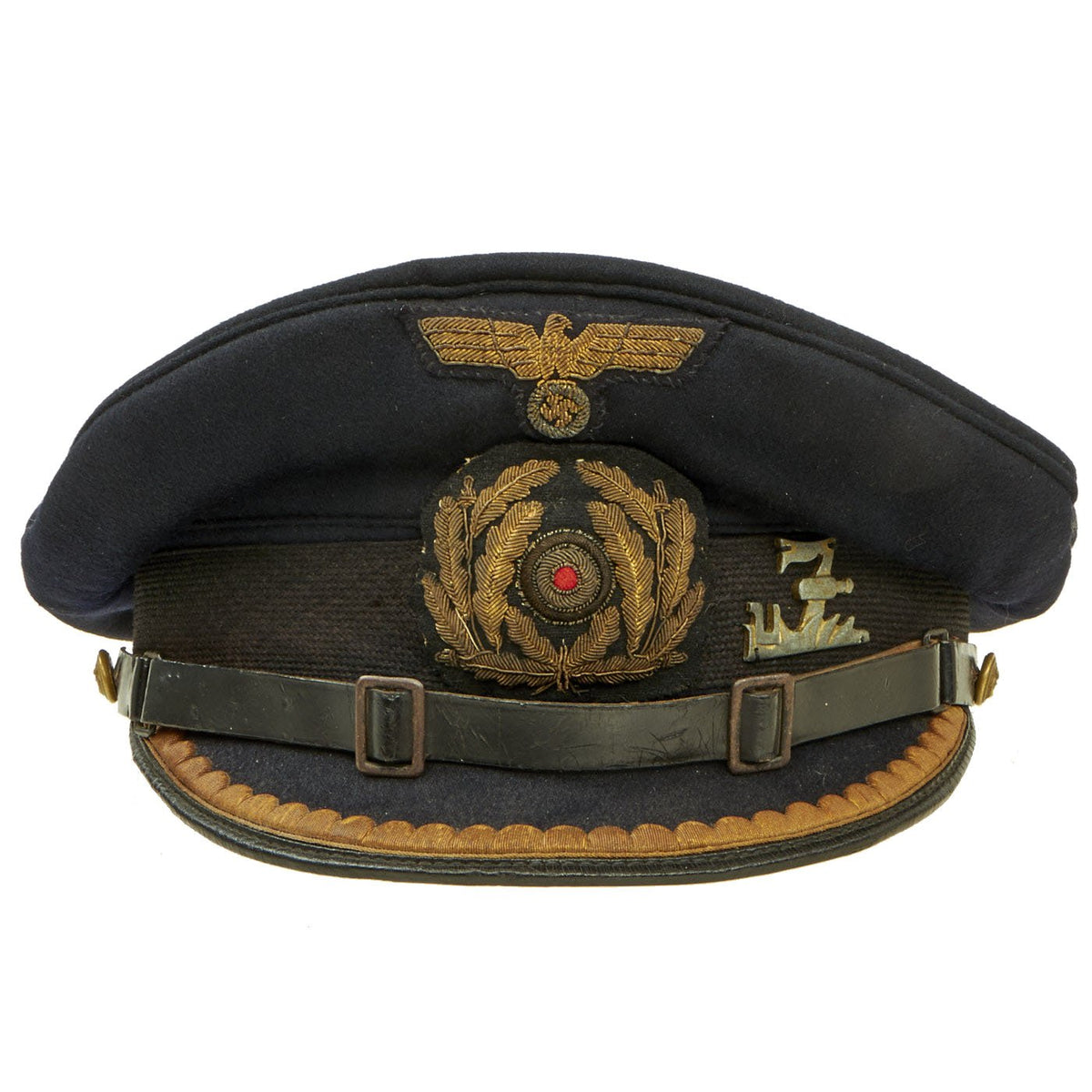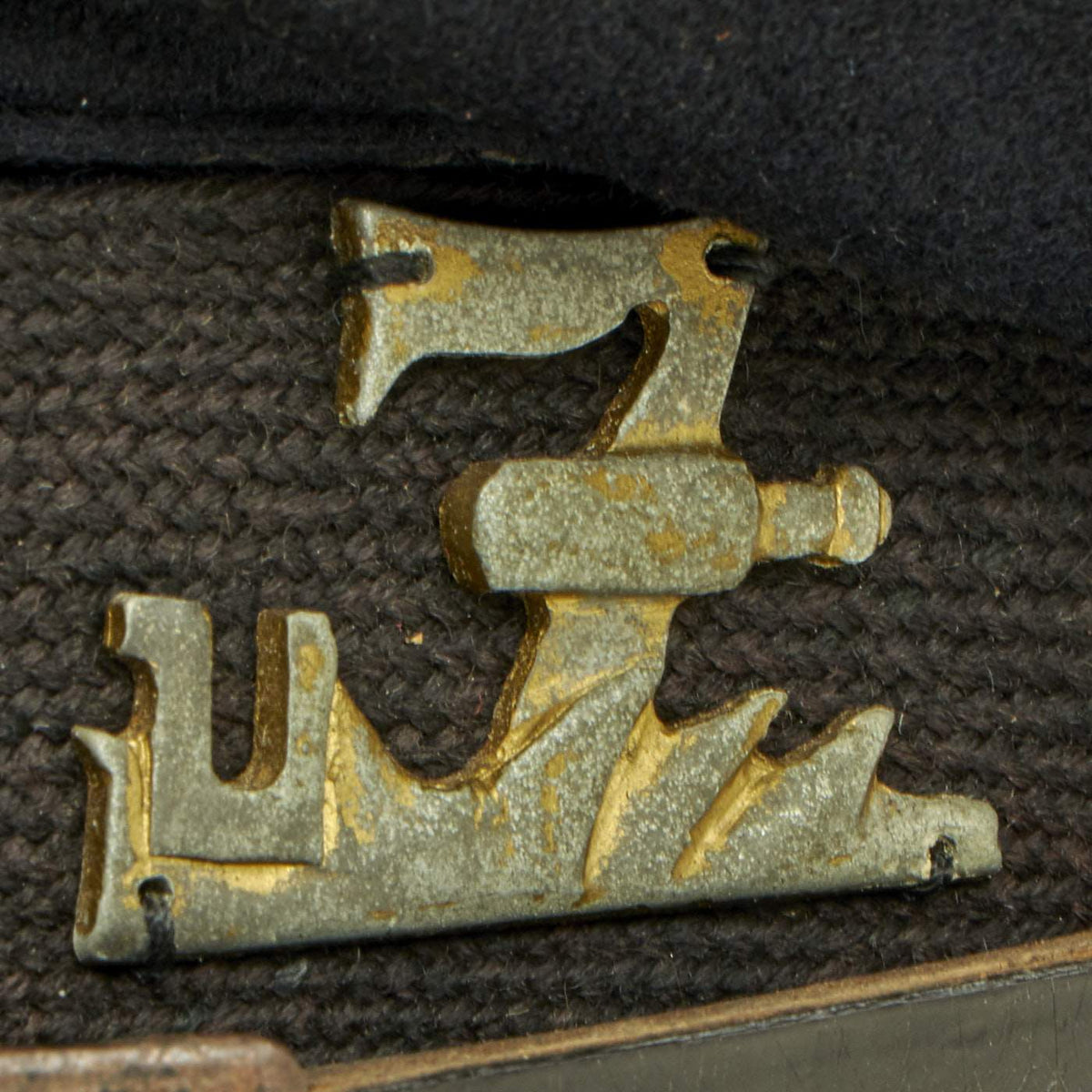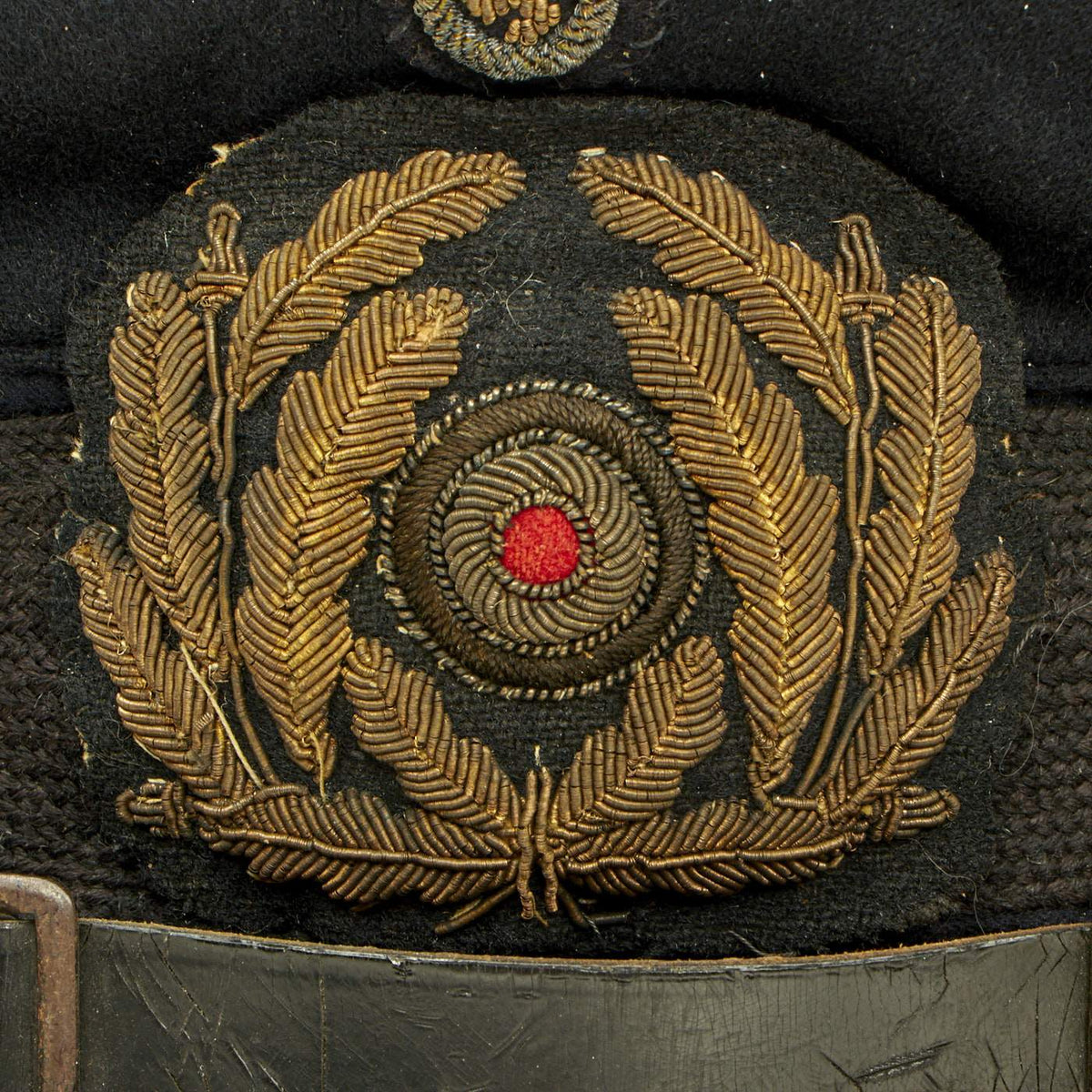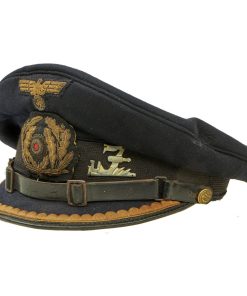Original German WWII Kriegsmarine U-Boat Navy Blue Named Junior Officer Visor Cap with U-777 Badge Original Items
$ 3.295,00 $ 823,75
Original Item: Only One Available. This is an incredible ultra rare German World War Two Kriegsmarine Naval U-Boat Submarine Junior Officer’s Schirmmütze (Visor Cap), with a genuine and scarce U-777 cap badge attached. The cap is named to Reinecke on a small label inserted into the celluloid crown sweat shield.
This cap looks to be an early issue version, as it does not have a removable cover, as many did. Also, the Reichsadler Insignia as well as the front cap badge wreath and tri-color cockade are all hand-embroidered with gold bullion thread. By the early WWII period typically the peak eagle would at least be a cast insignia, but not on this example. The badge is attached to the classic black coarsely woven band, which is partly covered by the black patent leather chin strap.
The visor has half leaf embroidery around the edge representing a junior or “company grade” officer. The interior features a classic Navy style blue silk or rayon lining with the standard celluloid sweat shield which holds the name tag. The sweatband is made from brown oil cloth faux leather, which has, unfortunately, somewhat deteriorated due to age.
The cap definitely shows wear, but it also has been cared for, and is mostly free of moth and any major structural issues. This will be an impressive and handsome addition to any German Kriegsmarine Naval display.
Overall a great condition totally genuine U-Boat junior officer’s visor cap!
German submarine U-777 was a German Type VIIC U-boat built in World War II, launched on 25 March 1944, and commissioned on 9 May, by its sole commander, Oberleutnant zur See Günter Ruperti.
German Type VIIC submarines were preceded by the shorter Type VIIB submarines. U-777 had a displacement of 769 tonnes (757 long tons) when at the surface and 871 tonnes (857 long tons) while submerged.[1] She had a total length of 67.10 m (220 ft 2 in), a pressure hull length of 50.50 m (165 ft 8 in), a beam of 6.20 m (20 ft 4 in), a height of 9.60 m (31 ft 6 in), and a draught of 4.74 m (15 ft 7 in). The submarine was powered by two Germaniawerft F46 four-stroke, six-cylinder supercharged diesel engines producing a total of 2,800 to 3,200 metric horsepower (2,060 to 2,350 kW; 2,760 to 3,160 shp) for use while surfaced, two Garbe, Lahmeyer & Co. RP 137/c double-acting electric motors producing a total of 750 metric horsepower (550 kW; 740 shp) for use while submerged. She had two shafts and two 1.23 m (4 ft) propellers. The boat was capable of operating at depths of up to 230 metres (750 ft).
The submarine had a maximum surface speed of 17.7 knots (32.8 km/h; 20.4 mph) and a maximum submerged speed of 7.6 knots (14.1 km/h; 8.7 mph).[1] When submerged, the boat could operate for 80 nautical miles (150 km; 92 mi) at 4 knots (7.4 km/h; 4.6 mph); when surfaced, she could travel 8,500 nautical miles (15,700 km; 9,800 mi) at 10 knots (19 km/h; 12 mph). U-777 was fitted with five 53.3 cm (21 in) torpedo tubes (four fitted at the bow and one at the stern), fourteen torpedoes, one 8.8 cm (3.46 in) SK C/35 naval gun, (220 rounds), one 3.7 cm (1.5 in) Flak M42 and two twin 2 cm (0.79 in) C/30 anti-aircraft guns. The boat had a complement of between forty-four and sixty.
It underwent training with the 31st U-boat Flotilla, but did not participate in any patrols during its five-month career of active service. It was destroyed at 20:02 hours on the night of 15/16 October 1944, during a British air raid on Wilhelmshaven, Germany, at position 53°51′N 08°10′ECoordinates: 53°51′N 08°10′E. One crewman was killed.
The German Schirmmütze Visor Cap:
The visor cap (Schirmmütze) was an important part of the headgear worn by German uniformed military, civil, paramilitary and political organizations during the Third Reich. This was the standard cloth headgear worn as a part of the service uniform. Visor caps were worn outdoors as well as indoors, and were often required to be worn by all personnel on duty. Visor caps were made in versions specific to each organization and were often further differentiated through the use of insignia, colored piping, or style of chin cord, to indicate rank, role or branch. The insignia used on these caps ranged from simple stamped metal emblems, to elaborate hand embroidery. Visor caps were issued to enlisted soldiers and NCOs in the military and in some other organizations. Officers had to purchase their own hats, and lower ranks could choose to purchase caps that were of a higher quality than the rather basic, issue examples. The private purchase caps were generally made in very high quality, with fine materials. A wide variety of fabrics were used, from Trikot and doeskin, to heavy wool, or even lightweight white fabric for summer wear. In the military, issue of these caps was generally suspended shortly after the outbreak of the war, but they continued to be worn by some troops until the end of the war.
Fast Shipping with Professional Packaging
Thanks to our longstanding association with UPS FedEx DHL, and other major international carriers, we are able to provide a range of shipping options. Our warehouse staff is expertly trained and will wrap your products according to our exact and precise specifications. Prior to shipping, your goods will be thoroughly examined and securely secured. We ship to thousands clients each day across multiple countries. This shows how we're dedicated to be the largest retailer on the internet. Warehouses and distribution centres can be located throughout Europe as well as the USA.
Note: Orders with more than one item will be assigned a processing date depending on the item.
Before shipping before shipping, we'll conduct a thorough inspection of the items you have ordered. Today, the majority of orders will be delivered within 48 hours. The delivery time will be between 3-7 days.
Returns
The stock is dynamic and we cannot completely manage it because multiple stakeholders are involved, including our factory and warehouse. So the actual stock may alter at any time. It's possible that you may not receive your order once the order has been made.
Our policy is valid for a period of 30 days. If you don't receive the product within 30 days, we are not able to issue a refund or an exchange.
You can only return an item if it is unused and in the same state as the day you received it. You must have the item in its original packaging.
Related products
Uncategorized
Uncategorized
Uncategorized
Uncategorized
Uncategorized
Uncategorized
Angolan Rebel 1970s era 60mm Inert Display Mortar from Angolan Civil War Original Items
Uncategorized
Uncategorized
Armoured Fighting Vehicles of the World: AFVs of World War One (Hardcover Book) New Made Items
Uncategorized
Uncategorized
Uncategorized
Uncategorized
Australian WWII Owen MK1 Machine Carbine SMG Custom Fabricated Replica with Sling Original Items
Uncategorized
Uncategorized
Uncategorized
